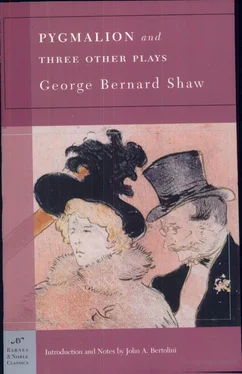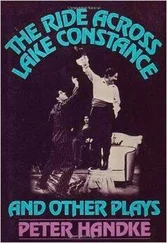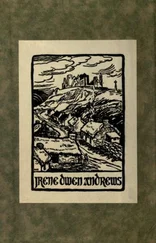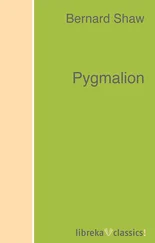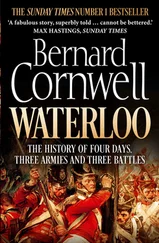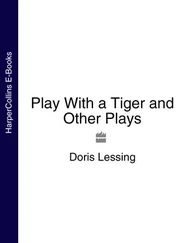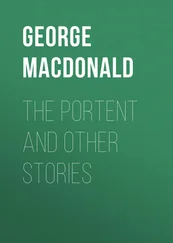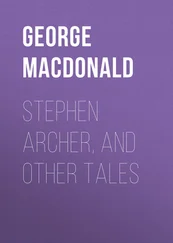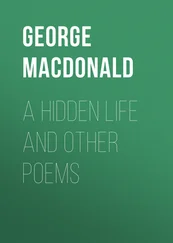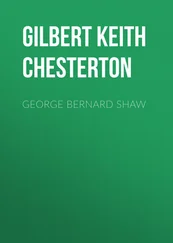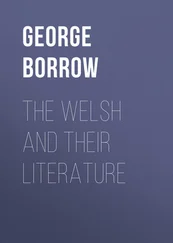In one of Katharine Hepburn’s early films, Morning Glory (from a 1933 play by Zoe Akins), Hepburn plays a self-confident, self-reliant, fearless, and outspoken young woman, ambitious to become a great actress in New York — in short, Hepburn plays herself. In the film, in an exchange with a producer (played by the ever-dapper Adolphe Menjou), Hepburn explains that she has done several major roles back home in her local Vermont theater company, including a role “in Shaw’s You Never Can Tell.” Menjou then asks, “Bernard Shaw?” and she replies, “The one and only.” They continue:
“You think Shaw’s clever?”
“He’s the greatest living dramatist.”
“You really think so?”
“I know it.”
She goes on to explain that she once wrote to Shaw and received a reply (which she carries with her), and that she will always have a Shaw play in her repertoire “as long as I remain in the theater.” The version of herself Hepburn plays here amounts to a version of the headstrong Shavian heroine. In the real theater world, Hepburn played the title role in one of Shaw’s late but not-quite-great plays, The Millionairess, in a New York and London production (1952). Some twelve years earlier, when she was starring in the film The Philadelphia Story, Shaw himself had suggested that she was just the sort of actress to play his millionairess. But even apart from her actual stage experience with Shaw, Hepburn, like her parents before her, was a Shavian — that is, influenced by Shaw’s ideas; full of unorthodox views, especially about religion; independent-minded; strong-willed. That was the appeal of Shaw in the 1930s, when the number of his plays that were part of the active repertory of the world’s theater — say twenty plays — was greater than that of almost any other playwright, Shakespeare, as always, excepted.
The modernists — Eliot, Joyce, Beckett — and modernism had not yet completely triumphed, so that Virginia Woolf and Leonard Woolf could argue about Shaw’s place in modernism, Virginia maintaining that Shaw was out of date, and Leonard asserting that if it had not been for Shaw’s work of educating the first generation of the twentieth century about everything, the modernists would have found no audience. So Shaw still could seem ahead of his time — enough ahead of his time for a most modern woman like Katharine Hepburn (and the character she played in Morning Glory) to admire him as a culture hero, an advanced thinker, and a modern playwright.
The four plays in the present volume are test cases both for Shaw’s achievement in drama and for the destinies of his headstrong heroines. The plays also give more trouble than those in Barnes & Noble Classics’s other edition of Shaw — Mrs. Warren’s Profession, Candida, The Devil’s Disciple, and Man and Superman — more trouble in that they have more unresolved chords than his earlier plays, and so are more difficult to understand; they reflect a Shaw troubled by the role of the artist in the world and by the world’s role in the universe. Heartbreak House, the last play in this edition, was written during World War I; it expresses Shaw’s struggle not to be defeated by all the evidence that the Devil in Man and Superman, who argued that Man is primarily a destroyer with his heart in his weapons, was right after all. Just the number of the war dead — the prodigiousness of which can be gauged by considering that United States fatalities for the whole of the Vietnam war, some 54,000, about equaled the number killed on one side on a single day of battle on the Western Front.
Major Barbara and its two predecessor plays — Afan and Superman (1903) and John Bull’s Other Island (1904; Shaw’s only major play about and set in his native Ireland) — form a trilogy on the theme of human destiny within a social order and a cosmic perspective, as Bernard Dukore has suggested in Shaw’s Theatre (see “For Further Reading”). All three plays use forceful images of heaven and hell, and debate propositions and ideas that would transform the world from a hellish place to a more heavenly one. But where Man and Superman projects an optimistic vision of human potential, both John Bull’s Other Island and Major Barbara end more ambiguously — that is, with the sense that any hope that humankind will put an end to war and waste remains in the realm of madness or fantasy — though Shaw still commits his characters to the fervent attempt to turn hope into reality. By the time Shaw wrote Heartbreak House, during World War I, he found himself a powerless witness to death and destruction on a massive scale such as the world had not seen. Heartbreak House records most precisely the reaction of the playwright to be like that of a man looking down from the top ledge of a skyscraper who becomes afraid, not that he will fall, but that he will jump. The tension in the play derives from Shaw’s instinct to resist yet give full expression to the allure of the jump that would let him be finally done with the world.
John Bull’s Other Island made Shaw famous and popular in 1904. Previously he had been something of a coterie dramatist with a few mildly successful plays to his credit. But the topicality of John Bull’s Other Island — together with the fortuitous attendance at a performance by King Edward, during which he laughed frequently and noticeably, and apparently with such gusto that he broke his chair — raised Shaw’s recognition and reputation to a hitherto unattained level. Certainly Shaw’s Irish play has its hilarious moments and episodes; but it is also suffused with sadness over the spiritual paralysis Shaw diagnoses as deriving from his countrymen’s tormenting imagination, which drives them to flee from reality to the bottle and futile dreams. The play’s embodiment of this tragic condition is a defrocked priest, Father Keegan, who expresses in the last scene an ideal social and metaphysical order:
In my dreams [Heaven] is a country where the State is the Church and the Church the people: three in one and one in three. It is a commonwealth in which work is play and play is life: three in one and one in three. It is a temple in which the priest is the worshipper and the worshipper the worshipped: three in one and one in three. It is a godhead in which all life is human and all humanity divine: three in one and one in three. It is, in short, the dream of a madman.
Yeats in his old age cited this speech of Keegan along with a very few other passages in literature as moving him greatly; the line “How can we know the dancer from the dance?” from Yeats’s poem “Among School Children” seems to echo Keegan. At its core Keegan’s dream proposes that all life is holy because it is whole, that the material and the metaphysical are indivisible, that the social and the spiritual are equally in need of attention. And though that proposition is presented as and perhaps acknowledged to be a madman’s dream, it lies at the heart of the ideas that Shaw’s next big play, Major Barbara, confronts.
MAJOR BARBARA
Major Barbara was successfully revived by the Roundabout Theatre in New York in 2001 The revival elicited the following encomium from Margo Jefferson, writing in The New York Times Book Review (August 5), after she has noted that “Shaw was a true artist, a master of multiple forms”:
The language and the complexity of the world Shaw made still excite. It isn’t just the war of wills between Barbara Undershaft, the society girl who turns to the Salvation Army in her need to do good and save souls, and her father, whose munitions empire commits him to war and destruction. It is out-of-work cockneys, young men about town and rich dowagers, all living on habit, instinct and the calculation needed to bridge the gap between what they have and what they want. And, in all Shaw’s work, it is the rigorous musicality of his language.
Читать дальше
